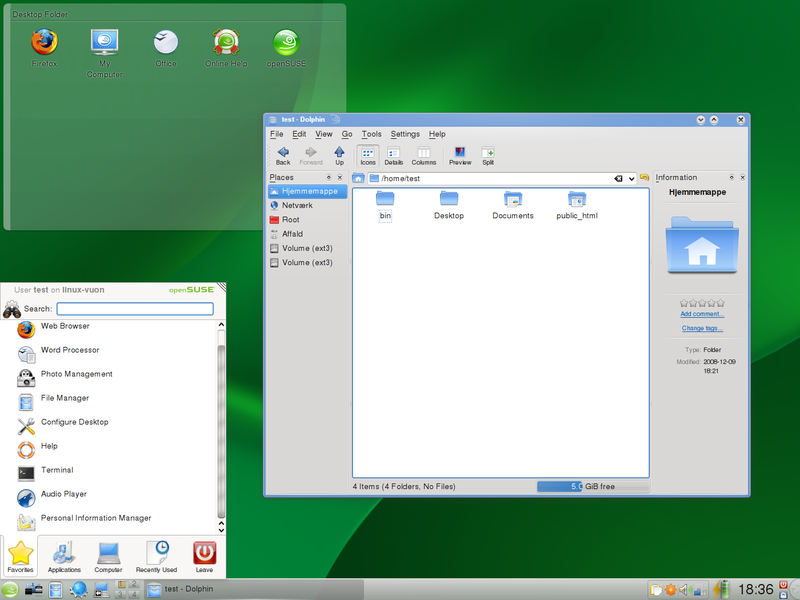

OpenSUSE is driven by the openSUSE Project community and sponsored by Novell, to develop and maintain SUSE Linux distributions components.
It is the equivalent of the historic "SuSE Linux Professional". After their acquisition of SUSE Linux, Novell has decided to make the
community an important part of their development process.Beyond the distribution, the openSUSE Project provides a web portal for community
involvement. The community assists in developing openSUSE collaboratively with representatives from Novell by contributing code through
the openSUSE Build Service, writing documentation, designing artwork, fostering discussion on open mailing lists and in Internet Relay
Chat channels, and improving the openSUSE site through its wiki interface. Novell markets openSUSE as the best, easiest distribution for
all users.Like most Linux distributions, openSUSE includes both a default graphical user interface (GUI) and a command line interface
option. During installation, the user may choose among KDE, GNOME and Xfce GUIs. openSUSE supports thousands of software packages across
the full range of Free software / open source development.
SYSTEM REQUIREMENTS :
OpenSUSE 11.1 has full support for 32 bit i686 and 64 bit x86-64 PC hardware, as well as PowerPC (PPC) processors. The basic requirements
for non-PPC hardware is as follows:
* CPU: Intel Pentium 1-4 or Xeon; AMD Duron, Athlon, Athlon XP, Athlon MP, Athlon 64, Sempron or Opteron
* RAM: 256 MB minimum, 512 MB recommended
* Hard drive: 500 MB for minimal system; 3 GB recommended for standard system
The actually achievable minimum specs differ. Older processors that still belong to the i586 family are usable, for example the AMD K6/2.
When excess language/translation files and documentation are removed and X is not needed, decent console-based router systems can be made
using 300 MB disk space. Most console workloads also cope with 128 MB RAM at the cost of increased swap activity in tight situations.

FEATURES :
YaST Control Center
SUSE includes an installation and administration program called YaST2 which handles hard disk partitioning, system setup, RPM package
management, online updates, network and firewall configuration, user administration and more in an integrated interface. YaST also
integrates with SaX2 to help users handle their graphics card and monitor, touch displays, and even additional monitors with Xinerama.
In more recent times, many more YaST modules have been added including Bluetooth support.
AutoYaST
AutoYaST is part of YaST2 and is used for automatic installation. The configuration is stored in an XML file and the installation happens
without user interaction.
ZYpp package management
ZYpp (or libzypp) is a Linux software management engine which has a powerful dependency resolver and a convenient package management API.
Build Service
The openSUSE Build Service provides software developers with a tool to compile, release and publish their software for many distributions,
including Mandriva, Ubuntu, Fedora and Debian.It typically simplifies the packaging process, so developers can more easily package a
single program for many distributions, and many openSUSE releases, making more packages available to users regardless of what distribution
version they use. It is published under the GPL.
Desktop innovation
In January 2, 2006, SUSE developer David Reveman announced Xgl, an X server architecture designed to take advantage of modern graphics
cards via their OpenGL drivers, layered on top of OpenGL via glitz. Compiz, one of the first compositing window managers for the X Window
System that is able to take advantage of this OpenGL-acceleration, was also released.
Desktop innovations (KDE)
SUSE has been a leading contributor to KDE for many years, and now SUSE sponsors more developers to work directly on KDE than any other
distribution. Hence, SUSE's contributions in this area have been very wide-ranging, and affecting many parts of KDE such as kdelibs and
kdebase, kdepim, and kdenetwork. Other notable projects include:
* KNetworkManager - a KDE front-end to NetworkManager.
* Kickoff - a new K menu for KDE.
Desktop innovations (GNOME)
The Ximian group became part of Novell, and in turn made and continued several contributions to GNOME with applications such as F-Spot,
Novell Evolution and Banshee. The GNOME desktop now uses the slab instead of the classic double-panelled GNOME menu bars


1. BURN The ISO on CD/DVD with PowerISO ( Recommended ) / Other TOOLS.
2. BOOT USING The DVD And FOLLOW The INSTRUCTIONS.
3. ENJOY .
*************************************************************************************************************************************************
For Step-By-Step Installation Guide :Click HERE
*************************************************************************************************************************************************


0 comments:
Post a Comment